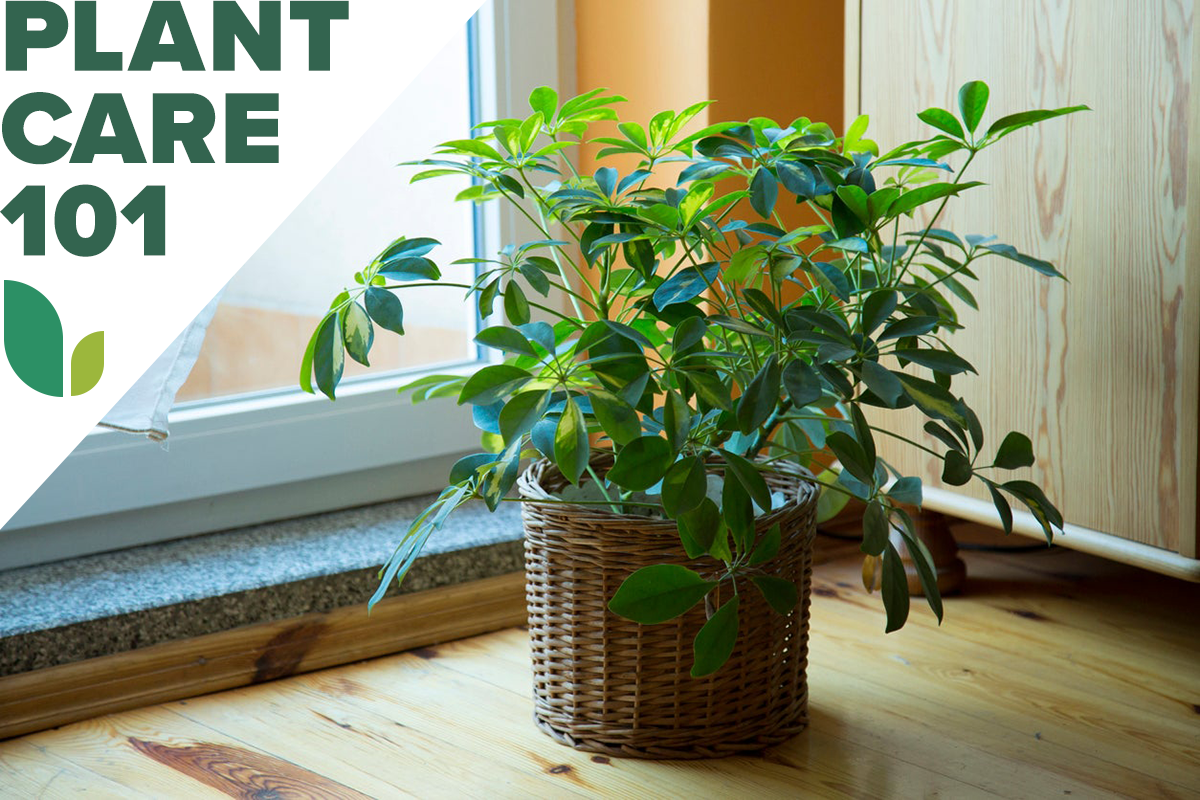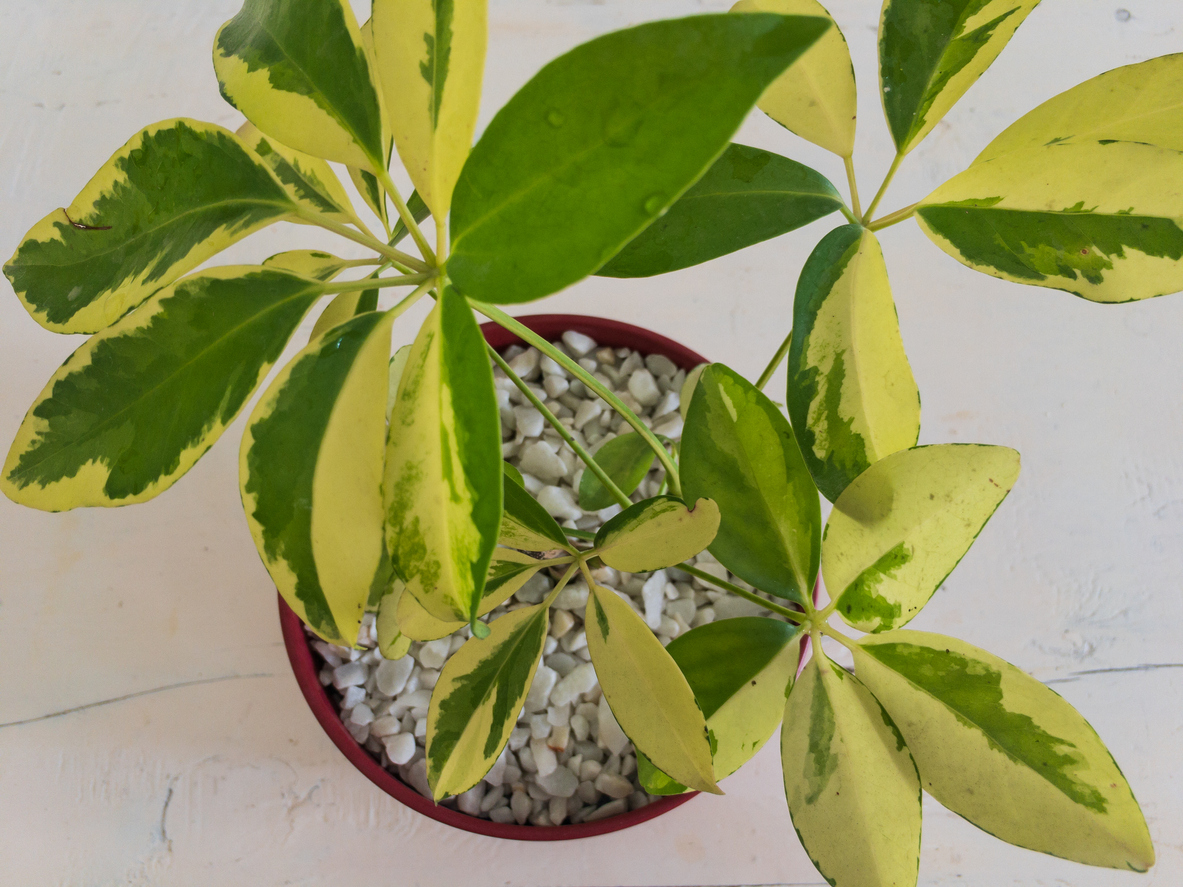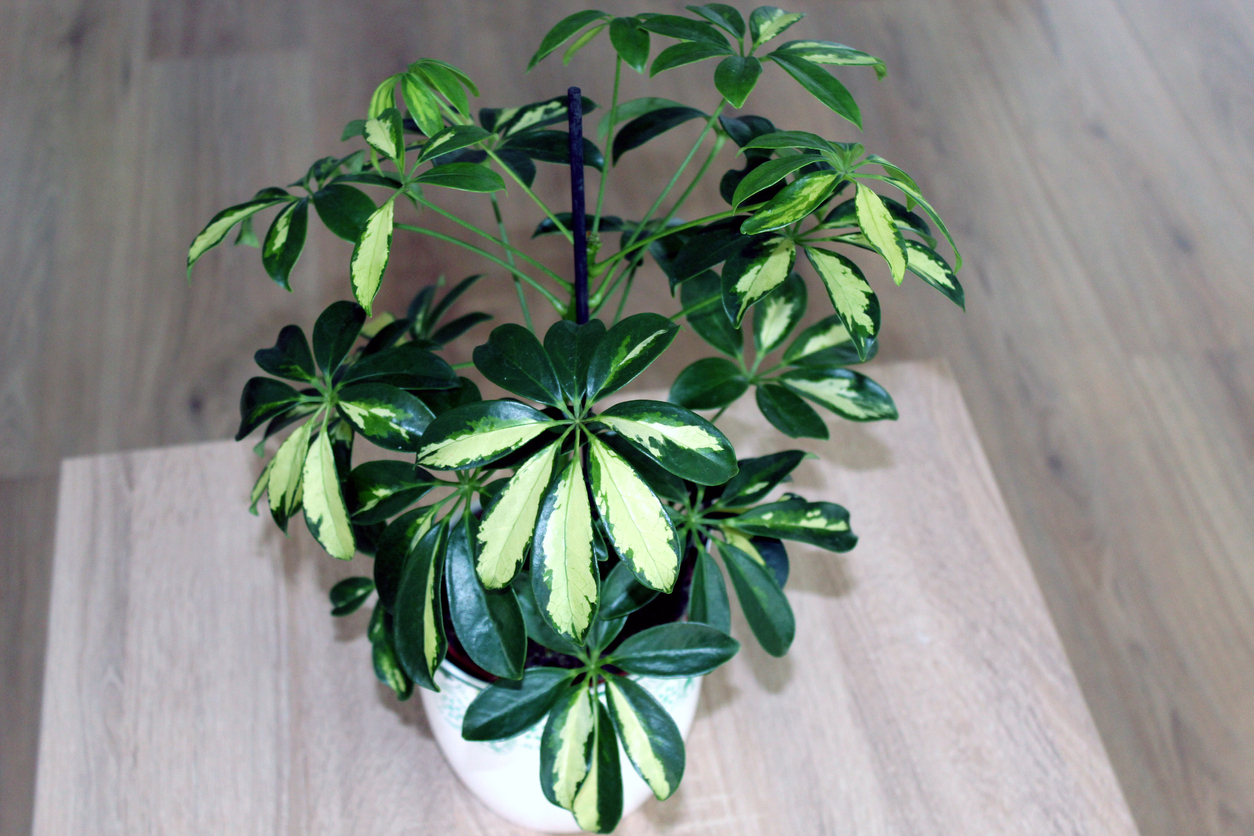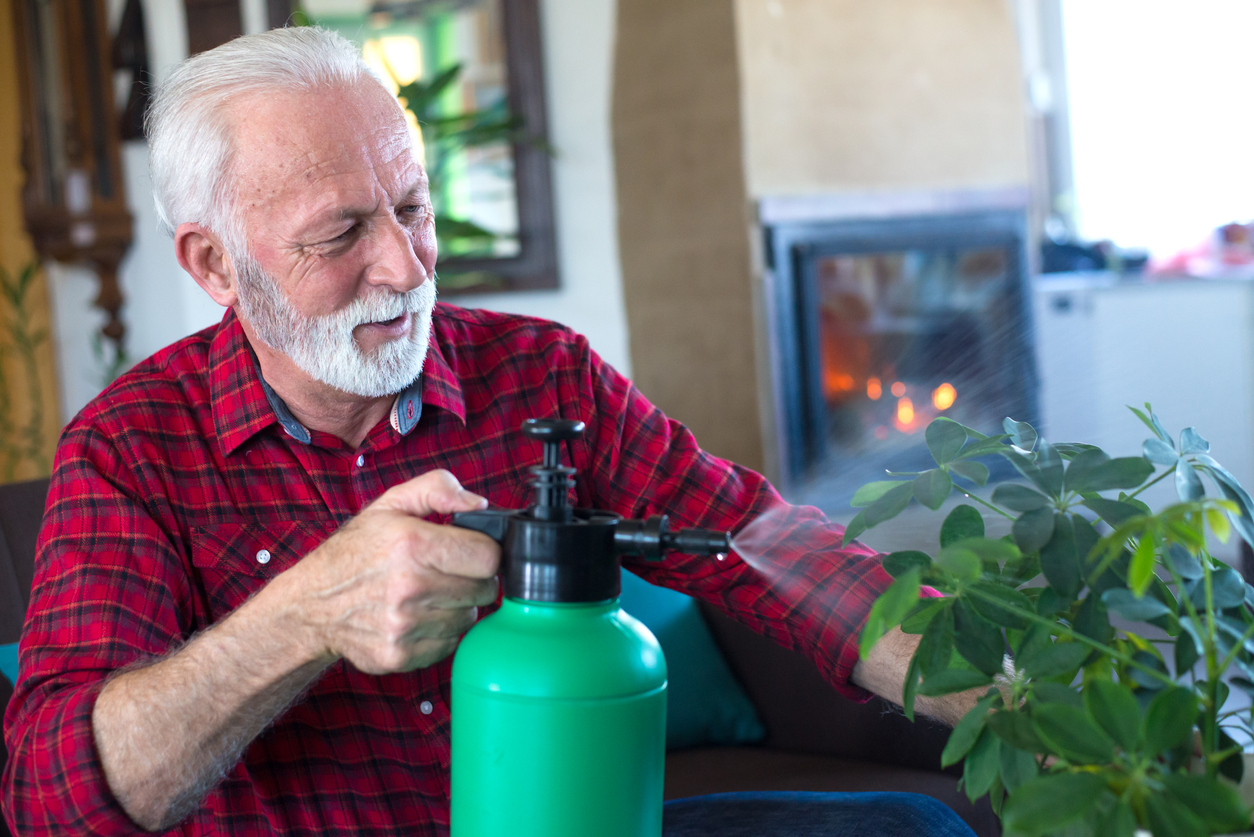

We may earn revenue from the products available on this page and participate in affiliate programs. Learn More ›
Umbrella plants are known for their whorls of glossy leaves. When they hang downward, the leaves resemble umbrellas or—when spread wide—many-fingered hands. Schefflera can occupy bright, protected corners in a living room or office for years without complaining.
These indoor trees are staid types, though. Should you suddenly decide to move one or subject it to “winds of change” (i.e., drafts or blasts of heat), umbrella plant care may turn challenging as its leaves drop in protest. The largest schefflera tree, S. actinophylla, can be invasive when grown outdoors in states such as Florida and Hawaii.
RELATED: 20 Huge Houseplants That Make a Statement
Umbrella Plant Care at a Glance
Common Name: Umbrella plant, schefflera
Scientific Name: Schefflera spp.
Soil: Standard potting mix
Light: Partial sun or bright, indirect
Water: Moderate
Food: Balanced or low-phosphorus plant food
Temperature and Humidity: Warm temperatures, high humidity
Propagation: Tip cuttings, air layering, or seeds
Safety: Toxic
Umbrella Plant Characteristics
Schefflera actinophylla grows to 40 or 50 feet high when outdoors in USDA hardiness zones 10 through 12. The plant’s leaves (actually whorls of oval leaflets) sometimes are composed only of four leaflets each when the plant is young, but eventually can include seven to 15, which extend up to 15 inches long.
Outdoors, the tree may produce greenish-yellow blooms that age to red on flower spikes radiating around a central stem like the upside-down spokes of an umbrella. Those blooms will be followed by reddish-purple berries ¼ to ½ inch in size.
The dwarf umbrella tree, Schefflera arboricola, is similar in appearance but tops out at about 15 feet, with usually no more than 10 leaflets per whorl, each no longer than 6 inches. Its ¼-inch orange berries ripen to black. Neither plant is likely to surpass 10 feet in height when potted, nor will they likely bloom indoors.
Types of Umbrella Plant
- Schefflera actinophylla ‘Amate’: A somewhat more compact version of S. actinophylla, this cultivar can grow to 10 or 11 feet in a pot and reportedly is resistant to leaf spot.
- Schefflera arboricola ‘Gold Capella’: This dwarf variety of the arboricola plant grows to only about 2 feet, its foliage splashed with yellow variegation.
- Schefflera arboricola ‘Janine’: This cultivar also tops out at a couple feet, its leaves decorated with white variegation.
Selecting Soil for Umbrella Plants

A standard potting mix that contains peat moss usually will suit the umbrella plant. Alternatively, try a combination of 2 parts peat moss, 1 part ground pine bark, and 1/3 part coarse builder’s sand. Place the schefflera tree in a container only about a third larger in diameter than its root ball.
Always use a pot with drainage holes to ensure that water doesn’t accumulate in the soil mix and cause the plant’s roots to decay. This especially applies if the schefflera will likely move outdoors during the summer months, since rainwater can build up quickly inside a non-draining pot.
The Right Light

The umbrella tree often grows in full sun outdoors and usually requires that much light to bloom. However, most sources recommend that houseplant types receive only partial sun—preferably in the morning—or bright indirect light for the best foliage color.
So, you can position the schefflera plant near an east-facing window or in a location where light bounces off of white or cream colored walls to keep it well lit. If you place it near a south- or west-facing window, curtain off the rays with a sheer drape between the plant and the glass. Although the plant sometimes is listed under low-light trees, aim for at least 250 foot-candles of illumination, and up to 1,000.
Watering Umbrella Plants
After watering an umbrella plant, wait until its soil is dry about 1 inch below the surface before irrigating the plant again with room-temperature water. It is somewhat vulnerable to root rot if kept too wet in a dim location. So, reduce the amount of water it receives in autumn and winter, making sure not to add moisture so frequently that the soil becomes soggy.
Limpness and yellowing of the older (lower) leaves, along with their eventual dropping, may indicate that an umbrella plant is “drowning.” However, such symptoms also can be caused by nitrogen deficiency or low light.
RELATED: Rubber Plant Care: Mastering This Trendy Indoor Tree
Fertilizing Umbrella Plants
An umbrella tree indoors doesn’t require much feeding, so fertilize it only once a month during spring and summer when it grows most rapidly—or no more than once every 2 weeks during those seasons. Plants receiving sun generally will require more nutrients than those that get little sunlight.
Use a balanced liquid houseplant formula intended for non-flowering species such as 20-20-20 or the organic 2-2-2. A high-nitrogen, low-phosphorus fertilizer such as 18-6-12 or the organic 2-1-1 also should be adequate for schefflera care.
Refrain from feeding the plant during autumn and winter. Since growth slows during that time, fertilizing then can cause excess salts in the soil.
Setting the Temperature and Humidity
The umbrella plant prefers temperatures between 70 and 80 degrees Fahrenheit during the day, down to no lower than 60 or 65 degrees at night. In winter, keep the plant away from doors and windows that aren’t well sealed, since cold drafts may cause it to develop dead spots on its leaves or to drop foliage.
The plant enjoys high levels of humidity but tolerates the lack of moisture reasonably well. However, to keep the umbrella plant as happy as possible, set it atop a humidity tray and mist it frequently or place it in a humid location, such as a bathroom.
Propagating Umbrella Plants

The University of Florida recommends 1-inch foliage-free stem cuttings taken from just below the uppermost leaves for propagating an umbrella plant. After snipping off those 1-inch pieces, lay them horizontally in a sterile medium such as damp seed starting mix or rooting gel and cover them lightly with the medium. Keep them warm and damp until they root. If working with a leggy plant, the more complicated air layering process might work better.
Seeds germinate most heavily if sown immediately after they are harvested, but also will keep for a while at room temperature. Soak them in hot water for 12 hours before sowing, barely covering them with damp seed starting mix. Keep the container at 75 to 85 degrees Fahrenheit until the seeds sprout, which may take 1 to 2 months.
Safety Considerations
If consumed, the umbrella plant is toxic to pets, people, and livestock due to the calcium oxalate crystals in its foliage. Those can cause irritation to the mouth and tongue when the leaves are chewed, as well as vomiting and drooling. Therefore, gardeners with young children or cats prone to nibbling on greenery probably will want to avoid growing it.
During pruning, the plant also can drip irritating sap on the hands when handling it. So it’s a good idea to wear plastic gloves when cutting back a schefflera and to rinse them off well under running water afterward.
Potential Pests and Diseases
Scheffleras are somewhat prone to leaf spots. If a plant shows dark brown spots—due to fungi or bacteria—try to keep its leaves dry by avoiding misting or overhead watering. Spots that appear to be made up of dead tissue instead can be caused by exposure to temperatures below 50 degrees, so keep the plant away from doors and ill-fitting windows and bring it indoors early in autumn.
As was previously mentioned, scheffleras also succumb easily to root rot brought on by overwatering and indicated by yellowing leaves, mushy stems, and other signs. If you suspect you have oversaturated the container, you may want to remove it from its pot, cut away the rotting roots, and determine whether enough good ones remain to pot it up again in drier soil.
RELATED: 10 Indoor Fruit Trees You Can Grow at Home Year-Round
FAQ About Umbrella Plant Care

To find some quick answers about umbrella tree care—all under the same umbrella—check out the questions below. If you’d prefer more leisurely learning, float about like Mary Poppins with her brolly through the more in-depth directions above to prevent any potential problems from raining on your plant’s parade.
Q. Do umbrella plants need sunlight?
No. Umbrella plants can thrive in bright indirect light as well as in partial sun.
Q. How often do you water an umbrella plant?
Water the plant whenever its soil has dried to 1 inch below the surface.
Q. Do umbrella plants like to be misted?
Yes. Umbrella plants prefer high humidity, so they will enjoy an occasional spritz from a misting bottle. Avoid spraying plants that are suffering from fungal or bacterial leaf spots.
Q. How do I make my umbrella plant bushy?
Whenever the plant threatens to become leggy, cut it back to whatever height you prefer.
Q. Can you take cuttings from umbrella plants?
Yes. The plant reportedly roots well from short stem cuttings, as detailed under “Propagating Umbrella Plants” above.
Q. Can I put my umbrella plant outside in the summer?
Yes. You can move an umbrella plant to an outdoor location in partial sun or light shade during summer, bringing it indoors again before temperatures fall below 50 degrees.
Looking for more low-maintenance houseplants? Check out our guides on caring for peperomia, air plant, and polka dot plant.
